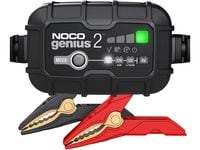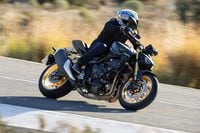Motorcycle battery chargers and maintainers do two important things: Keep your bike ready to run and make your battery last the longest possible time. How to choose a motorcycle battery charger? In the past, you often had to pick a 6-volt or 12-volt charger, or one for lead-acid-type batteries and another for lithium-ion (Li-ion) or lithium-iron-phosphate (LiFePO₄), but these three options from Noco, the Genius1, Genius2, and Genius5, combine a lot of useful features and flexibility to charge and maintain almost any battery used in a motorcycle or powersports application. One important point among these three different capacity battery charger/maintainers is that it is possible to use a larger-capacity charger on a smaller battery, but a smaller-capacity charger isn’t effective on a larger battery, so choose the size Noco Genius that suits your needs based on the amp-hour (Ah) capacity of the batteries you need to keep in top shape.
The Noco Genius1 is a 1-amp charger that, like the other Genius models here, charges lead-acid, AGM, and lithium-ion or lithium iron phosphate batteries in 6 and 12 volts. A 1-amp charger is a cost-effective, compact unit that plugs directly into a 220- or 110-volt outlet and will charge most any type of battery you choose for your motorcycle and other powersports applications. The lead-acid/lithium flexibility is probably the greatest strength of the Genius, but the ability to charge automatically from a battery depleted to as low a 1 volt is a nice touch. Even better, though, the unit includes a “force” mode that will work to charge a completely discharged battery that reads zero volt. You hope that never happens, but if it does, the Noco Genius1 can attempt to recover and renew the battery, also using its automatic detection of sulfation and acid stratification that helps eliminate these battery-harming conditions. The charger’s temperature sensor adapts to hot or cold ambient conditions to avoid over- or undercharging. The Noco Genius1 is designed for batteries with capacity as high as 30 Ah, and lithium batteries must have their own built-in battery management system. Its compact dimensions of 4.5 x 3.6 x 1.2 inches, makes it easy to pack or store. Included 21-inch charging leads connect to the 85-inch lead from the unit and include color-coded alligator clips and a quick-disconnect plug. The clips have integrated eyelets that allow their removal so leads can be connected to your battery terminals for plug-and-charge operation.
As the Noco Genius5 name implies, this is a 5-amp charger that will shorten charge times, particularly useful if you have a larger-capacity battery with a higher amp-hour rating of up to 120 Ah. It has the same useful features as the Genius1 and Genius2, in that it charges lead-acid, AGM, and lithium batteries in 6 and 12 volts, as well as having “force” mode, ambient temperature compensation, and desulfating mode. The plastic case dimensions of 4.6 x 2.9 x 1.9 are larger than those of the Genius1 and Genius2 to accommodate the increased power output. The Genius 5 also offers a mounting bracket and strap. The Genius5 costs a bit more, but it works on smaller batteries as well as the other units here while also doing larger batteries, so if you are looking for a one-charger solution that will cover most any motorcycle or powersports battery, this ends up being the most cost-effective choice. Total reach from AC wall plug to alligator clips is nearly 12-1/2 feet, the same as on the Genius2.
The Noco Genius2 charges at a maximum of 2 amps and is meant for batteries with a capacity as high as 40 Ah. In addition to greater capacity than the similarly sized Genius1, the Genius2 gets a 72-inch-long AC cord with wall plug (rather than going directly into the outlet like the Genius1), so you get longer reach to hit the corners of your garage. As with the other Genius chargers here, diagnostics include detecting a bad battery that may have an internal short or other problem, reversed polarity if the positive and negative leads are connected incorrectly, and “high voltage” if the charger is, for example, in 6-volt mode but connected to a 12-volt battery. There is also a “high-temperature” detector that will stop charging if the battery or ambient temperature is too high for safe operation. Across all three chargers in this list, state of charge and mode of operation are indicated by an assortment of clear, lighted symbols.
This article is sponsored by NOCO. Motorcyclistonline.com may receive compensation for purchases made through product links.













/cloudfront-us-east-1.images.arcpublishing.com/octane/OKWOJWAKP5EP3OACCRRWPCIX2Q.jpg)
/cloudfront-us-east-1.images.arcpublishing.com/octane/2WF3SCE3NFBQXLDNJM7KMXA45E.jpg)
/cloudfront-us-east-1.images.arcpublishing.com/octane/G4MG6OUCJNBSHIS2MVVOTPX65E.jpg)
/cloudfront-us-east-1.images.arcpublishing.com/octane/IIGGWFOTOJGB7DB6DGBXCCMTDY.jpg)
/cloudfront-us-east-1.images.arcpublishing.com/octane/QSTCM6AVEZA5JJBUXNIQ3DSOF4.jpg)
/cloudfront-us-east-1.images.arcpublishing.com/octane/U4I7G625B5DMLF2DVIJDFZVV6M.jpg)
/cloudfront-us-east-1.images.arcpublishing.com/octane/B6XD6LS6IVCQPIU6HXDJSM3FHY.jpg)
/cloudfront-us-east-1.images.arcpublishing.com/octane/ICL63FEDDRDTTMINYICCEYGMDA.jpg)
/cloudfront-us-east-1.images.arcpublishing.com/octane/FCGZHQXRBZFLBAPC5SDIQLVF4I.jpg)
/cloudfront-us-east-1.images.arcpublishing.com/octane/WNOB6LDOIFFHJKPSVIWDYUGOPM.jpg)

/cloudfront-us-east-1.images.arcpublishing.com/octane/X33NU3E525ECRHXLNUJN2FTRKI.jpg)
/cloudfront-us-east-1.images.arcpublishing.com/octane/6KKT5NNL2JAVBOXMZYS5ZO76YA.jpg)
/cloudfront-us-east-1.images.arcpublishing.com/octane/J5RKG5O455GMPGQRF2OG6LRT7A.jpg)
/cloudfront-us-east-1.images.arcpublishing.com/octane/GX2CIZKQVRH2TATDM26KFG2DAE.jpg)
/cloudfront-us-east-1.images.arcpublishing.com/octane/ZWIDYSAKQZHD5BHREMQILXJCGM.jpg)
/cloudfront-us-east-1.images.arcpublishing.com/octane/CYUHJZCTSJCH3MRAQEIKXK7SCQ.jpg)
/cloudfront-us-east-1.images.arcpublishing.com/octane/LKOFINY56FCXJCANJ5M7ZDQUBY.jpg)
/cloudfront-us-east-1.images.arcpublishing.com/octane/4NBPDACMWJH63JQYJVK3QRBDZI.jpg)
/cloudfront-us-east-1.images.arcpublishing.com/octane/KKHQHRR3FJGX7H2IPU6RALMWG4.jpg)

/cloudfront-us-east-1.images.arcpublishing.com/octane/5IOFS5JAE5FOXMNA23ZRAVVYUU.jpg)
/cloudfront-us-east-1.images.arcpublishing.com/octane/CGXQ3O2VVJF7PGTYR3QICTLDLM.jpg)
